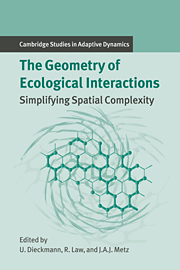Book contents
- Frontmatter
- Contents
- Contributing Authors
- 1 Introduction
- Part A Empirical and Statistical Background: A Plant Ecological Perspective
- Introduction to Part A
- 2 A Neighborhood View of Interactions among Individual Plants
- 3 Spatial Interactions among Grassland Plant Populations
- 4 Spatio-temporal Patterns in Grassland Communities
- 5 Statistical Modeling and Analysis of Spatial Patterns
- Part B When the Mean-field Approximation Breaks Down
- Part C Simplifying Spatial Complexity: Examples
- Part D Simplifying Spatial Complexity: Techniques
- References
- Index
- International Institute for Applied Systems Analysis
4 - Spatio-temporal Patterns in Grassland Communities
Published online by Cambridge University Press: 14 January 2010
- Frontmatter
- Contents
- Contributing Authors
- 1 Introduction
- Part A Empirical and Statistical Background: A Plant Ecological Perspective
- Introduction to Part A
- 2 A Neighborhood View of Interactions among Individual Plants
- 3 Spatial Interactions among Grassland Plant Populations
- 4 Spatio-temporal Patterns in Grassland Communities
- 5 Statistical Modeling and Analysis of Spatial Patterns
- Part B When the Mean-field Approximation Breaks Down
- Part C Simplifying Spatial Complexity: Examples
- Part D Simplifying Spatial Complexity: Techniques
- References
- Index
- International Institute for Applied Systems Analysis
Summary
Introduction
This chapter turns from the neighborhood processes of plants (discussed in Chapters 2 and 3) to the spatial patterns of plant communities. It provides some empirical background on what plant ecologists have learned about spatial patterns and their dynamics. In doing this, we examine criteria for distinguishing between patterns generated internally by biotic processes within communities and patterns generated externally by structural features of the abiotic environment. Although the focus of the chapter is primarily empirical, we describe several conceptual models that plant ecologists have considered while thinking about the dynamics of spatial pattern.
Spatial patterns play a pivotal part in plant community dynamics. When we look at these patterns, we see the outcome of a complex series of past events – including the biotic processes of birth, death, and movement, and some element of chance – together with the structure of the abiotic environment. At the same time, we see a baseline on which future events depend; how spatial patterns unfold through time depends on their previous states. Through these dynamics, large-scale patterns emerge that cannot be predicted from local processes, because these processes are coupled to the global pattern of the community. This coupling will become a major theme in later chapters of the book.
Spatio-temporal Patterns in Plant Communities
Ecologists have long recognized the importance of spatial pattern in terrestrial plant communities and have devoted considerable effort to documenting the patterns that occur (Blackman 1935; for reviews see Pielou 1968; Greig-Smith 1983; Kershaw and Looney 1985). The locations of plants in such communities can be thought of as patterns in a two-dimensional space.
Information
- Type
- Chapter
- Information
- The Geometry of Ecological InteractionsSimplifying Spatial Complexity, pp. 48 - 64Publisher: Cambridge University PressPrint publication year: 2000
Accessibility standard: Unknown
Why this information is here
This section outlines the accessibility features of this content - including support for screen readers, full keyboard navigation and high-contrast display options. This may not be relevant for you.Accessibility Information
- 26
- Cited by
